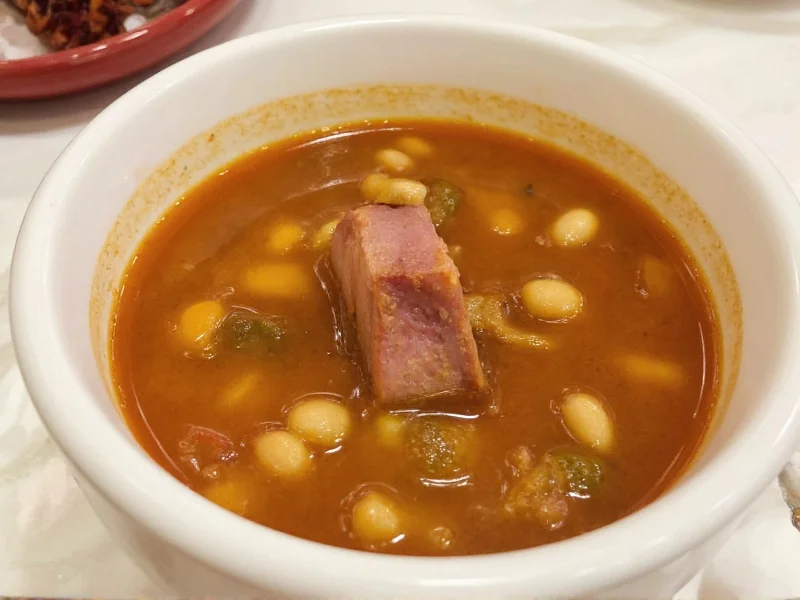The Timeless Appeal of Ham Bone and Bean Soup
For generations, home cooks have turned humble ham bones into hearty, flavorful soups. This traditional preparation method maximizes flavor while minimizing waste—a practice that remains relevant in today's economy-conscious kitchens. Unlike store-bought versions, homemade ham bone and bean soup develops complex flavors through slow simmering that no canned alternative can replicate.
Why This Recipe Works: Culinary Science Behind the Simmer
The magic of ham bone and bean soup happens through three key processes: collagen conversion, flavor layering, and starch gelatinization. As the ham bone simmers for hours, collagen breaks down into gelatin, creating that signature rich mouthfeel. Meanwhile, the beans absorb smoky ham flavors while releasing starches that naturally thicken the broth. This chemical transformation can't be rushed—proper simmering time is non-negotiable for authentic texture and depth.
Essential Ingredients and Their Purpose
Understanding each component's role ensures consistent results every time you make this traditional bean soup with ham bone:
| Ingredient | Function | Substitution Options |
|---|---|---|
| Ham bone (2-3 lbs) | Provides smoky depth and meaty texture | Ham hock, smoked turkey leg, or 1 cup smoked paprika for vegetarian version |
| Dried beans (16 oz) | Creates hearty texture and thickens broth | Navy, Great Northern, or cannellini beans work best |
| Mirepoix (1 cup diced) | Builds flavor foundation | Equal parts onion, carrot, celery |
| Apple cider vinegar (2 tbsp) | Enhances flavor and helps beans soften | Lemon juice or white vinegar |
Step-by-Step Preparation Guide
Follow these professional techniques for perfect ham bone soup every time:
Preparation (30 minutes)
- Sort and rinse 16 ounces dried beans, removing any debris
- Soak beans overnight in cold water (reduces cooking time by 30%)
- Prepare mirepoix: 1 cup total of finely diced onion, carrot, and celery
- Remove excess fat from ham bone but retain meaty portions
Cooking Process (8-12 hours)
- Place soaked beans, ham bone, and 8 cups cold water in 6-quart pot
- Bring to gentle boil, then reduce to simmer (small bubbles breaking surface)
- Add mirepoix and 2 bay leaves after first hour of simmering
- Maintain consistent low simmer for 6-10 hours (longer = more flavor)
- Add 2 tbsp apple cider vinegar during last hour to brighten flavors
- Remove ham bone, shred meat, and return to pot
- Season with black pepper and salt to taste (ham provides significant salt)
Avoiding Common Ham Bone Soup Mistakes
Even experienced cooks make these preventable errors:
- Adding salt too early - Wait until beans are tender, as salt can toughen bean skins
- Boiling instead of simmering - Vigorous boiling breaks beans and creates cloudy broth
- Skipping the soak - Unsoaked beans take 50% longer to cook and may not soften properly
- Overlooking acidity - The vinegar addition in final hour balances richness and enhances flavor perception
Storage and Reheating Techniques
Proper storage maintains quality for future meals:
- Cool soup within 2 hours of cooking to prevent bacterial growth
- Store in airtight containers with 1-inch headspace (soup expands when frozen)
- Refrigerate for up to 5 days or freeze for 6 months
- Reheat frozen portions by thawing overnight in refrigerator first
- Add splash of water or broth when reheating to restore ideal consistency
Adapting for Different Dietary Needs
This traditional ham bone and bean soup recipe accommodates various preferences:
- Vegetarian version: Replace ham bone with smoked paprika and liquid smoke; use vegetable broth
- Lower sodium: Rinse ham bone thoroughly and omit additional salt; use low-sodium broth
- Gluten-free: Naturally gluten-free (verify ham bone hasn't been processed with gluten)
- Slow cooker method: Cook on low for 8-10 hours after initial boiling step
Serving Suggestions for Maximum Enjoyment
Elevate your homemade ham bone soup experience with these pairings:
- Crusty artisan bread for dipping (sourdough works particularly well)
- Freshly grated Parmesan cheese sprinkled on top
- Simple green salad with vinaigrette dressing
- For heartier meal: Serve over cooked rice or with cornbread
Why This Soup Deserves a Place in Your Recipe Collection
More than just a way to use holiday leftovers, this traditional bean soup with ham bone represents culinary wisdom passed through generations. The slow transformation of simple ingredients into something extraordinary demonstrates how patience yields superior results. Unlike quick-fix alternatives, this method develops layered flavors that satisfy both the palate and the soul—a true testament to the adage that the best things in life are worth waiting for.











 浙公网安备
33010002000092号
浙公网安备
33010002000092号 浙B2-20120091-4
浙B2-20120091-4